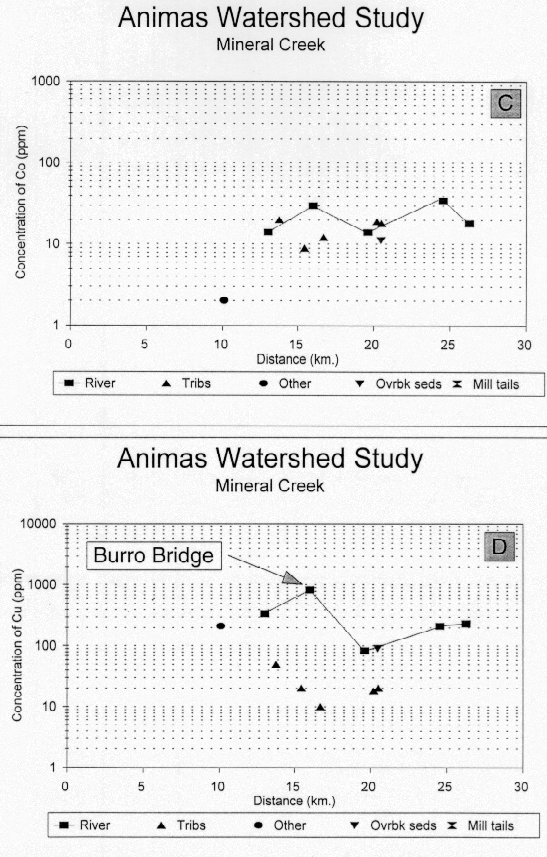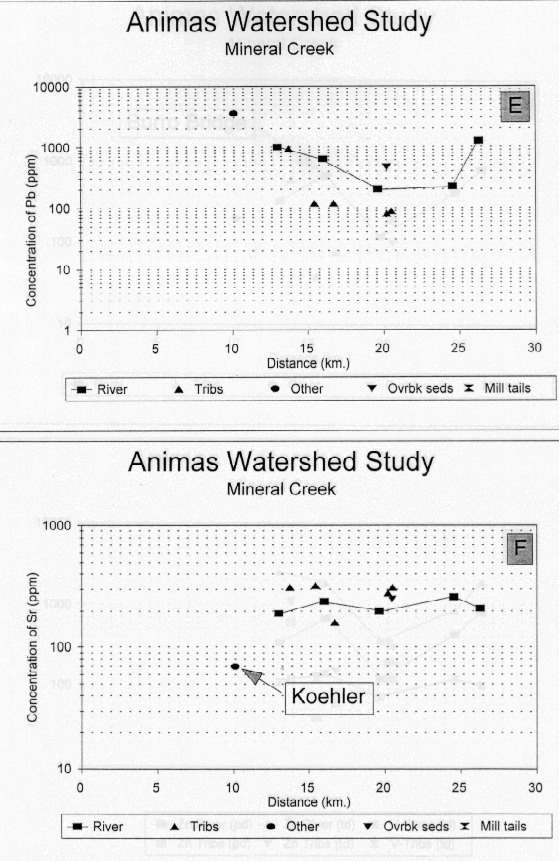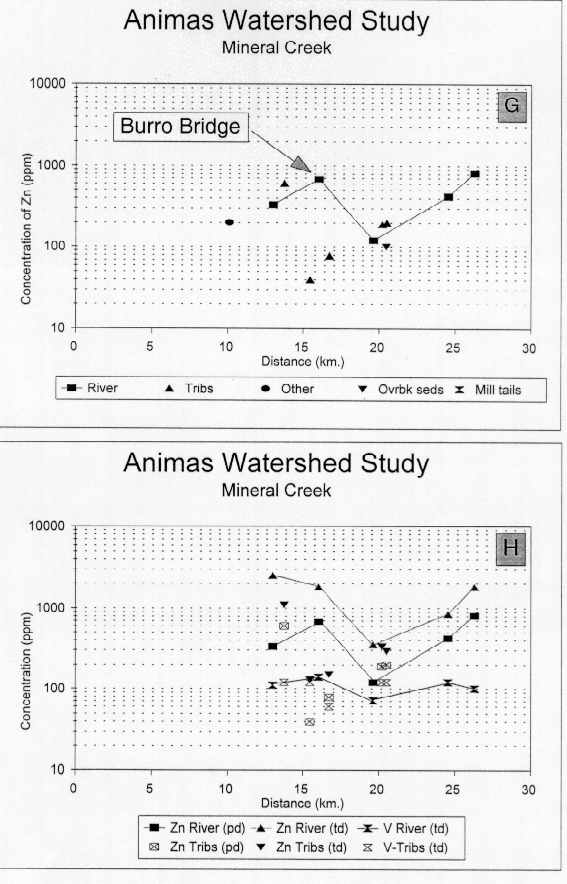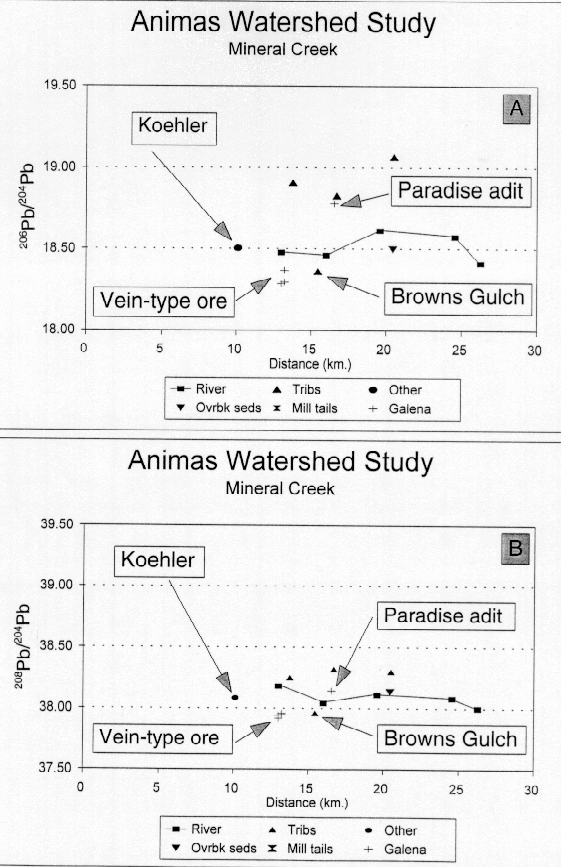Geochemical and lead-isotopic results from the bed sediments from Mineral Creek are summarized in figures 22-23. At the headwaters of Mineral Creek, an iron-hydroxide precipitate sample from the Koehler adit contains enriched concentrations of ore-related metals. This sample was totally digested by the 2M HCl-1%H 2O2 leach demonstrating that metals deposited by precipitation from aqueous AMD solutions in the iron-hydroxides phases are completely extracted by this acid leach solution. The Koehler adit drains into a small collection basin from one of the chimney deposits (fig. 4), which are base-metal-rich breccia pipes associated with porphyry-type mineral deposits (Cox, 1986). Direct discharge of sediments into the headwaters of Mineral Creek from the collection basin below the Koehler adit is not certain. The data from the Koehler adit discharge is used in this report to indicate that the chimney deposits are a source, rather than the only source of these metals.
Arsenic concentration in the Koehler adit sample (4,400 ppm) is about 2,500 times CAV. The concentration of arsenic in bed sediments of Mineral Creek downstream from the Koehler adit show a continuous dilution of arsenic resulting from addition of sediments from the tributaries in the basin (fig. 22A). Arsenic is diluted from about 130 times CAV on the upper part of Mineral Creek at Chattanooga to about 11 times CAV above the confluence with the Animas River below Silverton. A comparison of the yields for arsenic in the 2M HCl-1%H2O 2 digestion versus the total digestion indicates that arsenic is consistently present in the bed sediments at a concentration of 20-30 ppm higher in the total digestion on a sample-to-sample basis (fig. 22B). This indicates that arsenic is present in both the iron-hydroxide phase as well as in a sulfide phase, probably arsenopyrite. At the Chattanooga site, as much as 85-90 percent of the arsenic may have come from the Koehler adit or from acid mine drainage directly from these chimney deposits. There is no direct measure of the arsenic component that may have been derived from the altered area surrounding the mineral deposits on Red Mountain.
______________________________________________________________________________________ | |||
|---|---|---|---|
Locality |
206 Pb/204Pb |
207 Pb/204Pb |
208 Pb/204Pb |
______________________________________________________________________________________ | |||
Sunnyside Mine1 |
|||
DH-B1 |
18.285 |
15.556 |
37.919 |
74BRD-4 |
18.294 |
15.563 |
37.949 |
74BRD-3 |
18.367 |
15.562 |
37.959 |
Sunnyside Mill1 |
|||
66DV-1 |
18.549 |
15.603 |
38.242 |
Eureka Mill Site2 |
|||
95ABS105-GN |
18.228 |
15.537 |
37.787 |
Kittimac Mill Site2 |
|||
95ABS106 |
18.787 |
15.635 |
38.278 |
Galena in float, Cement Creek2 |
|||
95ABS120-GN |
18.367 |
15.551 |
37.944 |
Paradise portal, Gem claim2 |
|||
95ABSPD |
18.781 |
15.581 |
38.142 |
Marcella Mine, Kendall Mountain1 |
|||
46DV39 |
18.498 |
15.595 |
38.056 |
______________________________________________________________________________________ | |||
Cobalt concentration is low in the sample from the Koehler adit, and the cobalt concentrations in the total digestions of the bed sediments of Mineral Creek are only slightly elevated above the concentrations in the tributaries (fig. 22C). The cobalt concentrations in the bed sediments of Mineral Creek are at or near CAV (29 ppm)and range between 10 and 30 ppm. Cobalt concentrations show no regular increase or decrease along the entire course of Mineral Creek. Comparison of the partial (labile) and total digestion data indicates that some portion of the cobalt is probably being transported in the bed sediments in pyrite.
Copper concentrations are about three times CAV (210 ppm) at the Koehler adit, are elevated to 5.6 times CAV at Chattanooga, and rise to about 13 times CAV at Burro Bridge above the confluence of the Middle Fork of Mineral Creek (fig. 22D). Below the Middle Fork of Mineral Creek to the confluence with the Animas River, the concentration of copper drops to 100-110 ppm (about 1.5 times CAV) indicating that there are no substantive sources of copper to the bed sediments of Mineral Creek in these stream reaches. About 30-50 ppm of copper occurs in the sulfide phases, probably in chalcopyrite or a solid-solution component in pyrite. The increase in the copper concentration at Burro Bridge is entirely in the labile phase. Copper concentrations in bed sediments from the main tributaries to Mineral Creek are not supplying substantial amounts of copper to the bed sediments in these stream reaches. The source of the copper in the upper reaches of Mineral Creek has not been identified.
Lead concentrations at Koehler adit are 3,500 ppm (about 270 times CAV). Lead concentrations from bed sediments in the headwaters of Mineral Creek at Chattanooga (about 70 times CAV) and at Mill Creek (about 60 times CAV) indicate that the lead baseline is significantly elevated here (fig. 22E). Substantial mineral production and milling were done in the Red Mountain district near Chattanooga beginning in 1882 (Sloan and Skowronski, 1975). The chimney deposits at the headwaters of Mineral Creek are a major source of lead in the bed sediments of Mineral Creek. Lead concentrations from tributaries, including the Middle Fork of Mineral Creek, are in the range of 90-140 ppm. Lead concentrations drop to 200-240 ppm (15-18 times CAV) in bed sediments in the reach between the South Fork of Mineral Creek and the confluence with the Animas River below Silverton. Lead concentrations in the two digestions are essentially the same small differences between the measured concentrations are presumed to be due to sample heterogeneity.
Strontium concentration data from the total digestion of the bed sediments shows that there is relatively little strontium in the Koehler adit sample relative to that in the rocks being eroded within the basin. The strontium profile for Mineral Creek is relatively flat and the strontium concentrations in bed sediments from the tributaries brackets the concentration profile for bed sediments in Mineral Creek (fig. 22F). The average strontium concentration (223 ppm) is below the CAV (384 ppm).
Labile zinc in the sample from Koehler adit is 200 ppm or about 2.6 times CAV. Zinc concentrations in the bed sediments differ substantially between the 2M HCl-1%H2O2 digestion (fig. 22G) and the total digestion (fig. 22H) suggesting that a substantial portion of the zinc in the bed sediments is transported in the sulfide mineral sphalerite. Sphalerite accounts for as much as 85 percent of the zinc in the bed sediments from the site at Chattanooga. Substantial sphalerite is also being added to this stream reach from Browns Gulch. The sphalerite component in the bed sediments of Mineral Creek drops to about 60 percent at Burro Bridge and the zinc concentration in the iron-hydroxide phase is also increased as did the concentration of labile copper at this site. Stream flow at the site above Burro Bridge was slow the increase in metals associated with the colloidal phase in the bed sediments may be the result of accumulation of colloidal components at this site. Both sphalerite and labile zinc concentrations drop substantially between the Middle and South Forks of Mineral Creek. Downstream of the confluence of the South Fork, sphalerite and labile zinc concentrations again increase dramatically as Mineral Creek enters the mining area west of Silverton.
The profile of vanadium concentrations from the total digestion (fig. 22H) is relatively flat along the course of Mineral Creek averaging 110 ppm (CAV is 136 ppm), although the vanadium profile for Mineral Creek shows more variation than that for Cement Creek or the upper Animas River upstream from Silverton. Vanadium concentrations from tributaries are close to the values from the Mineral Creek samples and indicate that the samples from these localities are not significantly biased by hydrologic concentration of heavy minerals at any particular site. The site above the confluence of the South Fork of Mineral Creek does have low concentrations of vanadium suggesting that this sample may be somewhat biased toward the iron-hydroxide component rather than the heavy-mineral phases. We conclude that the elevated zinc concentrations are the result of addition of sphalerite to the stream reaches rather than concentration of heavy-mineral phases in a placer.
The lead-isotopic data (fig. 23A and B) from the Mineral Creek drainage indicate metals from several different deposit types are being added to bed sediments from the mineral deposits in the basin. Since there are no published lead-isotopic data from the chimney deposits, the results from the Koehler adit will be used as the signature of this deposit type. The lead-isotopic data available on galena from known mine sites or stream reaches is shown in these diagrams. Note that the composition of lead in the bed sediment from Chattanooga does not match well with the Koehler adit results for 208Pb/204Pb, and that it is even more enriched in 208Pb relative to the vein-type ore deposits than lead-isotopic data from the Koehler adit. The lead-isotopic data from Mill Creek and from the Middle and South Forks of Mineral Creek, all of which are on the west side of the Mineral Creek drainage, have lead-isotopic values that are more radiogenic than the vein-type ore signature whereas the bed-sediment sample from Browns Gulch matches the Eureka graben vein-type ore signature. The composition of lead in the sample from Burro Bridge on Mineral Creek above the confluence of the Middle Fork reflects the addition of vein-type ore lead from Browns Gulch. Between the confluence of Middle and South Forks of Mineral Creek, the lead-isotopic data indicate that the influence of the Eureka graben vein-type ore lead is being diluted by the addition of rock lead similar to that found in the tributaries on the west side of the Mineral Creek drainage. The overbank sediment sample from the confluence of the South Fork, however, matches the geochemical and lead-isotopic data from the upper reaches of Mineral Creek and represents a fluvial high-water deposit that contains a larger component of ore and ore-related metals from the upper part of the basin. The lead-isotopic composition in bed-sediments from Mineral Creek at low flow is higher than that of the Eureka graben vein-type ore lead signature, indicating that a different component of ore lead dominates the composition of lead in bed sediments from this drainage. This is not the case for bed sediments from Cement Creek or the upper Animas River above Silverton as will be shown below.




